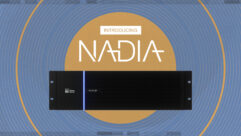
Meyer Sound Announces Self-powered Mini Loudspeaker
Oct 17, 2007 12:00 PM
More AV in Education news from
The Briefing Room

Meyer Sound has announced the new MM-4XP miniature loudspeaker, a self-powered version of the popular MM-4 miniature wide-range loudspeaker. With a face measuring just 4in. square, this compact product is designed for high-quality distributed systems where space is at a premium and in which a single light gauge cable can deliver both balanced audio and DC power over a long cable run of up to several hundred feet.
The new MM-4XP’s flexible and easy-to-configure mounting options, ability to reproduce both speech and music with very low distortion, operating frequency range of 120Hz to 18kHz, and peak output of 113dB SPL make it an outstanding choice for fixed installations. This loudspeaker is particularly well-suited to stage lip frontfill, fill and spot coverage, installation in steps and other hidden locations, and small portable systems often used in corporate AV applications.
“Demand for a self-powered loudspeaker this size has been strong since the day we launched the original MM-4,” says company President and CEO John Meyer. “But it was our experience building the larger, high-output loudspeakers M’elodie and UPJunior that enabled us to create a powerful box of this size. I believe this signifies a major breakthrough for self-powered loudspeakers.”
The MM-4XP meets the same exceptional performance standards established by the MM-4: it delivers the high intelligibility and flat frequency and phase responses for which Meyer Sound loudspeakers are known, while adding the advantages of self-powered systems, with all amplification and corrective processing onboard.
The MM-4XP has a single, proprietary, 4in. cone transducer that is manufactured at Meyer Sound’s Berkeley, Calif. factory. Peak and rms limiters regulate loudspeaker temperatures and excursion, ensuring that the MM-4XP performs exceedingly well even when driven into overload.
Balanced audio and 48VDC power from an MPS-488 external power supply are received on a five-pin Switchcraft EN3 connector. The EN3 connector has been successfully used on the weather-protected version of the MM-4 for years, and offers the dual advantages of small size and excellent protection against adverse environmental conditions, facilitating use of the MM-4XP in outdoor applications. The use of composite multiconductor cables (such as Belden 1502R) allows a single cable to carry both audio and DC power to the MM-4XP.
The 1RU MPS-488 external power supply is required for use of the MM-4XP. It provides 48VDC power to up to eight MM-4XPs, while also routing eight channels of balanced audio from its XLR inputs to the five-pin EN3 connectors on its eight channel outputs.
The MM-4XP’s amplifier and signal-processing circuits are designed to store DC power and tolerate voltage drops, enabling the delivery of high peak SPL without high instantaneous peak DC current draw. This accommodates light-gauge cables of lengths up to 500ft. to be used between an MPS-488 channel output and an MM-4XP. Powering the MM-4XP from a unipolar external power source reduces induced noise significantly and eliminates the need for wiring conduits.
The MM-4XP’s extruded aluminum enclosure acts as a heat sink to dissipate heat from the driver’s voice coil. The enclosure features a perforated steel grille, and is available in a standard black anodized finish, or, optionally, custom painted to match specific color schemes. An MM-4XP U-bracket is available for mounting the loudspeaker on walls and ceilings at adjustable angles.










